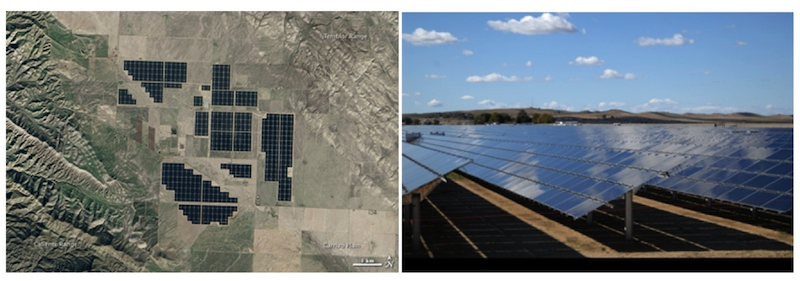6.3. Architecture of the large-scale PV systems
Development of large solar PV plants has been underway in a number of countries, especially where the government-backed incentives and legislation were in place to support renewables. Since 2000, installation of MW-scale PV systems has been initiated in Germany, Spain, Italy, Greece, and further taken into even larger scale in U.S., China, India, and Brazil. The trend really picked up after 2007, when the number of the more than 1 MW systems grew from 20 to over 100 within a few years. Industry experts predict that the trend will hold and perhaps even accelerate into the future as the demand for renewable energy resources escalates. The average and maximum size of the utility solar plants (typically 5 MW to 500 MW) increases as well. The Topaz Solar Farm, located in San Luis Obispo County, California, is one of the largest solar photovoltaic power plant in the U.S. (Figure 6.3). This facility has the capacity to generate 550 megawatts (MW) of solar electricity using 5 million panels.

The list of the world's largest PV plants is updated from year to year, and you can see that Topaz benchmark has been already beaten repeatedly now, and the top facilities currently exceed GW limit. One of the attractive factors of the utility PV plants is that those facilities can be built relatively quickly (within 6-12 months) due to modular structure, unlike major hydroelectric, geothermal, or fossil fuel facilities, which would be typically developed over 3-5 year span. This presents a great opportunity for emerging economies to effectively meet their growing energy demands, especially since many of those countries possess an excellent solar resource.
Initially, the PV plant design is developed at the stage of feasibility assessment, which includes estimation of solar resource and expected yield. Then, the plant design is further improved, taking into consideration other local limitations and constraints. The feasibility stage also includes site measurements, topography mapping, environmental setting assessment, and social impacts. Key design features include such technical information as PV module type, tilting angle, mounting and tracking systems, module arrangement, and balance of system (BOS) components - inverters, connections, switches, and storage solutions. Further optimization of plant design would deal with such issues as shading, performance degradation, and economic trade-offs between increased complexity and energy yield.
The design of a utility scale PV plant is a complex endeavor. With many available choices of components and options for optimizing performance, it is important to strike a balance between cost savings and quality. Engineering decisions require significant technical expertise and should be "informed" decisions based on both optimization models and practical experience.
The following reading will introduce the main principles of the design of very large PV systems.
Reading Assignment
Here you will have a chance to study different aspects that need to be considered during the PV plant design and construction. Advances in system architecture, civil works, operational regimes allow significant cost reductions and better marketability of the solar energy in those regions.
Komoto, K., Ito, M., van der Vleuten, P., Faiman, D., and Kurokawa, K., Energy from the Desert, Chapter 7. MW-Scale PV System Installation Technologies, pp. 86-98.
Abbreviations in the reading:
- VLS-PV - very large scale photovoltaic
- PCU - power conditioning unit
- MVA - megavolt ampere
- DC - direct current
- AC - alternate current
- IGBT - insulated gate bipolar transistor
- EPC - engineering, procurement, construction
Following this reading, please take the reading quiz in Canvas (see Module 6).
